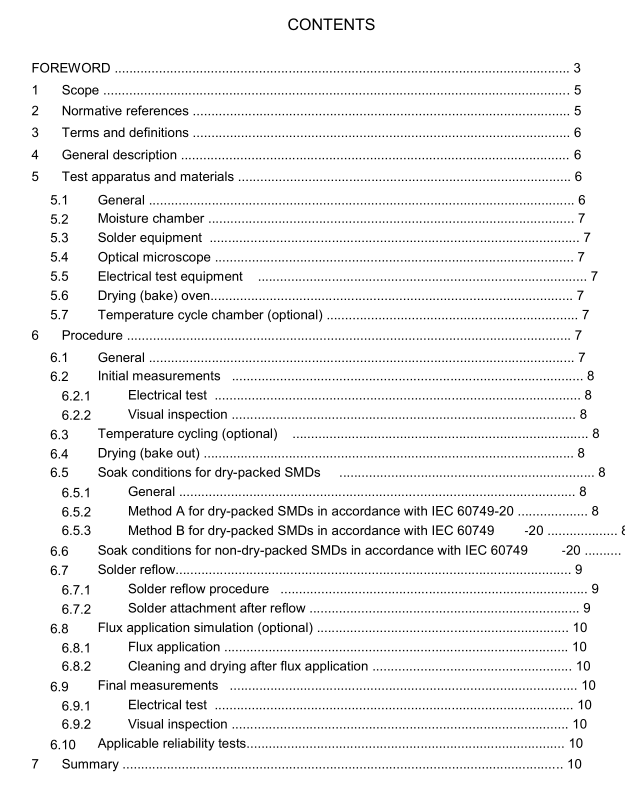IEC 60749-30 pdf – Semiconductor devices – Mechanical and climatic test methods – Part 30: Preconditioning of non-hermetic surface mount devices prior to reliability testing

IEC 60749-30 pdf – Semiconductor devices – Mechanical and climatic test methods – Part 30: Preconditioning of non-hermetic surface mount devices prior to reliability testing
5.2Moisture chamber
Moisture chamber(s) capable of operating at 85 °C/85 % RH (relative humidity),85°C/60 %RH,85 *C/30 % RH,30 °C/70 % RH and 30 “C/60 % RH. Within the chamberworking area,temperature tolerance shall be t2 “C and the RH tolerance shall be ±3 % RH. A chamber with
60“C/60 % RH capability is optional for accelerated soak conditions.
5.3Solder equipment
Solder equipment shall consist of the following.
a) 100 % convection reflow system capable of maintaining the reflow profiles required by thisdocument. This is the preferred equipment for solder reflow.
b) VPR(vapour phase reflow) chamber capable of operating the temperature profiles inIEC 60749-20 ‘with appropriate fluids. The chamber shal be capable of heating thepackages without collapsing the vapour blanket and of re-condensingthe vapour tominimize loss of the vapour phase soldering liquid. The vapour phase soldering fluid shall
vaporize at the appropriate temperature specified above.
c) Infrared (IR)/convection solder reflow equipment capable of maintaining the reflow profiles
required by this document. It is recommended that this equipment use the lR to heat theair and not directly impinge upon the components under test.
d) Wave-solder equipment capable ofmaintaining the conditions in6.4.4 of
IEC 60749-20:2020.
NOTE The moisture sensitvity conditin(classification) test results are dependent upon the package bodytemperature,rather than board or lead temperature.Convection and VPR are known ‘to be more controllable andrepeatable than lR.Wnen there are correlation problems between VPR,IR/conwvection,convection and wave soldserfused),the conwection resuls are considered as the standard.
5.4Optical microscope
Optical microscope (40X for external visual examination).5.5Electrical test equipment
Electrical test equipment capable of performing room temperature DC and functional tests.
5.6Drying (bake) oven
Oven for drying (bake) capable of operating at 125
0+5 “c.
5.7Temperature cycle chamber (optional)
A temperature cycle chamber capable of operating as a minimum over a range of -40 -100C to*60 *10cin accordance with IEC 60749-25. Acceptable alternative test conditions ando ” auuluan – p
temperature tolerances are found in Table 1 of lEC 60749-25;2003. This equipment is onlyrequired if 6.3 is used.
6Procedure6.1 General
lt is recommended that a prior evaluation be run according to the moisture sensitivitylevels(MSLs) detailed in IEC 60749-20, using the appropriate method and similar devices,todetermine which preconditioning ‘sequence is suitable,i.e. likely to pass. Other moistureevaluation data can be consulted.However, the soak sequence in 6.5 needs to be consistent
with the floor life information in Table 1 and Table 2.
Reflow requirements are provided for both Pb-free and legacy SnPb conditions and are usedbased on the intended end use of the SMD.The same package can have different MSL levels
depending on whether the SnPb or Pb-free reflow is used.
At all times the test parts shall be handled using appropriate ESD procedures.
6.2Initial measurements
6.2.1 Electrical test
Perform an electrical DC test and functional test to verify that the devices meet the roomtemperature data sheet specification.Replace any devices that fail to meet this requirement.
6.2.2Visual inspection
Perform an external visual examination under 40X optical magnification to ensure that nodevices with external cracks or other damage are used in this test method. lf mechanicalrejects are found, corrective action shall be implemented in the manufacturing process and anew sample drawn from a product which has been processed with the corrective action.
6.3Temperature cycling (optional)
Perform 5 cycles of temperature cycle from -40 °C (or lower) to +60 °℃ (or higher) to simulate
shipping conditions (the shippability option). This step is optional unless required by therelevant specification.
6.4Drying (bake out)
Bake the devices for at least 24 h minimum at (125土5)°℃. This step is intended to removemoisture from the package so that it will be “dry” .
NOTE 1 This time is modified if desorplion data on the particular device being preconditioned shows that more orless time is required to obtain a “dry” package.
NOTE 2 lf the preconditioning sequence is being performed by the semiconductor manufacturer,steps 6.2.1,6.2.2 and 6.4 are optional since they are at theR supplier’s own risk.if the preconditioning sequence is beingperformed by the user,step 6.8 is optional.
6.5Soak conditions for dry-packed SMDs6.5.1General
The following soak conditions shall apply. lt is recommended that the soak be initiated within2 h of bake.
6.5.2 Method A for dry-packed sMDs in accordance with IEC 60749-20
This test shall be carried out in accordance with 6.3.3.2, method A, of lEC 60749-20:2020 andTable 1 of this document.









